I’ve Always Had a Round Face and Weak Jawline—One Sofwave Laser Treatment Changed That
Just look at my before and afters.
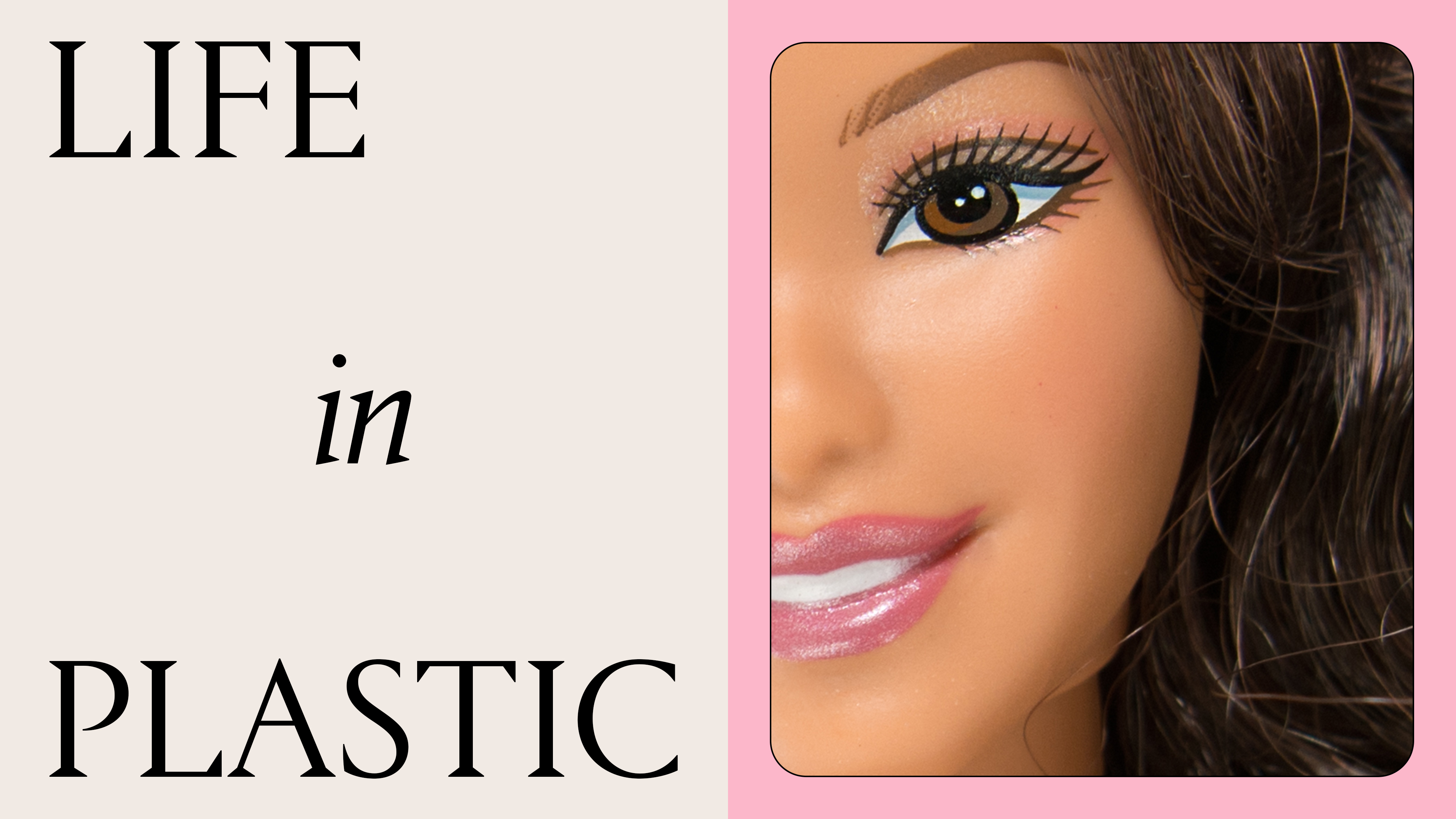

Nothing gets us more excited than talking about a not-so-little tweakment or a nip-tuck procedure. In the spirit of transparency, Marie Claire’s aesthetics column, Life in Plastic, delivers a first-hand peek into what goes on behind the doctor’s door.
For a beauty editor, I’m objectively pretty tame when it comes to facial cosmetic procedures. I haven’t done Botox or filler or tried super intense lasers like Fraxel or CO2. I’m certainly not opposed—just give me a decade. I’m 28 (but according to VISIA, my skin age is 24, for what it’s worth), don’t have any static lines or wrinkles, and I'm overall content with my skin texture. I take care of my skin for sure (I’m not in this industry for nothing), but I thank my mom’s and grandmother's genes for my Good Skin.
What I don’t thank them for? Our multi-generational round face—and complete lack of a jawline.
I mean this with no shade or offense, but after seeing how a weak jawline evolved on my mom (56) and grandmother (84), I’m intent on doing everything in my power to preventatively sculpt my jawline and avoid what my family (lovingly) refers to as “frog neck.” I do my gua sha and facial yoga. I use my microcurrent devices religiously. But I also recently decided to do my first Big Girl laser treatment: Sofwave.
Sofwave has been around since 2016 and has become a very valued tool for skin tightening. “It uses ultrasound technology to deliver controlled heat at a precise depth in the mid-dermis,” explains Sarah Bonner, the CEO and founder of TREAT Medspa in New York City. “This thermal effect stimulates the body’s natural wound-healing response, which in turn triggers new collagen and elastin production.” Sofwave, which costs roughly $2,000 to $4,000 depending on location and provider, is designed to bypass the skin’s surface and target only the layers responsible for firmness and elasticity, which makes it effective for lifting the brows, tightening the jawline, and improving skin laxity.
I’ve heard (and seen) great things—my aunt (53) has gotten Sofwave on her jaw several times over the past few years and it’s genuinely transformed her face. It’s also pretty low lift for a facial laser (the downtime is non-existent, so all I needed was to set aside two hours of my life), and frankly, it doesn’t take much convincing for me to test something out that promises a stronger, more lifted jawline. I was hopeful for sure, but I was not expecting the results to be nearly as dramatic as they are. My face is slimmed (basically in half) and not only do I have a jawline for the first time in my life, but my face actually looks angular.
For the full breakdown on my Sofwave experience, read ahead.
Get exclusive access to fashion and beauty trends, hot-off-the-press celebrity news, and more.
The Prep
Because Sofwave is pretty low-lift and works for almost everyone (I’d avoid it if you have heat-triggered skin conditions like melasma), I didn’t need to have a consultation. That being said, if you’re concerned it’s not the best option for you or are interested in exploring other options, always set aside time to discuss alternatives with your provider.
I’ve heard that Sofwave can be a little spicy on the pain scale, so I took two extra strength Tylenol about 30 minutes before my appointment to help with not only discomfort, but also to prevent me from clenching my jaw too intensely. I washed off all my makeup (you’re told to come with clean skin) and then made my way over to TREAT Medspa.
The Intake
Once I arrived, the first thing the team had me do was take “before” photos on their Aura Skin Scanner. It’s much more advanced than a typically camera shot—it captures a 3D image of my face and neck, analyses facial structure, skin condition, skin volume, and is able to detect the direction skin is being lifted—or sagging.
Then they brought me into a treatment room, where they cleansed my face once again with some micellar water and applied numbing cream all over my face and neck. It’s a white cream that gets applied with a popsicle stick onto all areas that will be targeted with the laser. It doesn’t feel tingly—just a little cold. It does however take forever and a half (roughly 45 minutes to an hour) to kick in, so I recommend bringing your computer and getting some work done or downloading a show to pass the time.
The Treatment
Once it was time for the treatment to begin, the numbing cream had fully kicked in. It wasn’t so much that I couldn’t feel my face, but any sensation was dulled and making facial expressions felt like my muscles were working in slo-mo.
I decided to really focus my Sofwave on my “submental region,” which is the neck, jawline, and bottom half of my face, so my technician told me to expect the whole shebang to last roughly 45 minutes (if we didn’t take any pain breaks). She applied a conductive gel over the area that was going to be treated—it allows the heat of the device to penetrate the deeper layers of the skin it needs to.
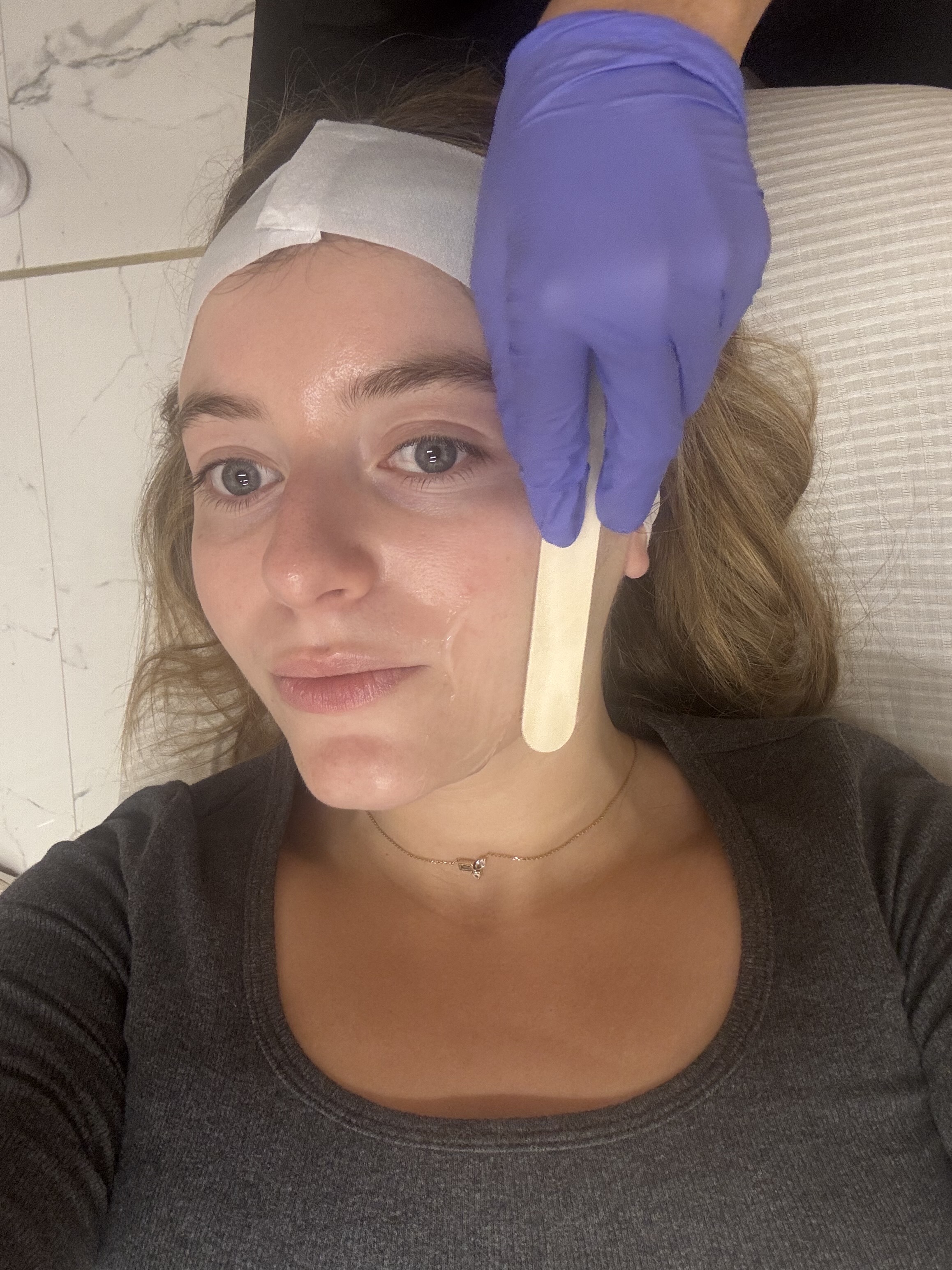
Samantha Holender having conductive gel spread on her skin before a Sofwave treatment.
Then, she powered the machine on. I have a pretty high pain tolerance (I find laser hair removal to be a breeze and PRP, where my own blood was injected into my scalp to stimulate hair growth, really didn’t bother me), so I assumed this would be an easy treatment and asked for the highest setting. Plus: the Sofwave machine is equipped with a cooling plate that prevents the surface of your skin from getting too hot.
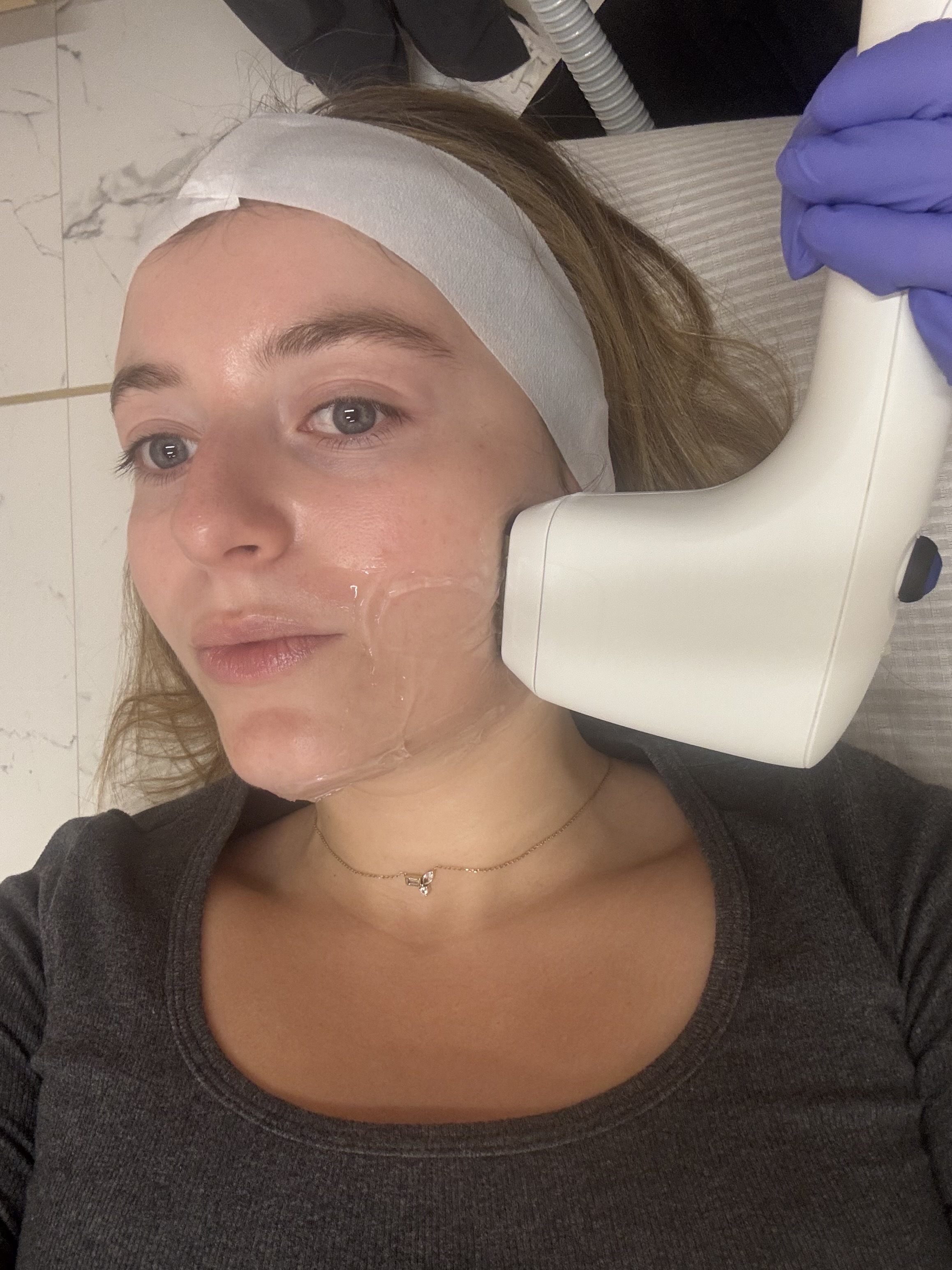
Samantha Holender receiving the Sofwave treatment.
I couldn’t have been more wrong. I personally found this laser to be pretty uncomfortable. For context, the tip of the device is shaped like a square and each section needs to receive a stamp. It gets held on every spot for roughly five seconds—the first two seconds are a breeze, but the final three had me feeling like fireworks were going off underneath my skin. It’s almost like you put your hand on a hot stove and instead of whipping your hand back when you feel the heat register, you let it linger there for three more seconds than you know you should.
But once the device is lifted from the section and moves onto the next, the pain completely dissipates—there’s no lingering (thank god). The catch: each little square of skin needs to be treated with two to three passes. By the end, my internal body temperature was so high (it felt like a hot flash) and every part of my body was sweating. But! It wasn’t so bad that I needed to take a break or stop altogether and in less than an hour, I was totally done.
The Recovery
The best part about Sofwave: it’s a lunchtime treatment. I left my session with maybe a hint of redness (which dissipated by the time I got home) and some risidual numbness from the numbing cream that wore off in an hour or two. That being said, there’s no immediate gratification with Sofwave; my face looked the same when I left as when I came in. “Because Sofwave is stimulating your own natural collagen remodeling process, results aren’t instant. It taes time for the body to lay down new collagen fibers and for those fibers to organize and strengthen,” explains Bonner. “This process unfolds gradually, so improvements typically become noticeable around eight to 12 weeks after treatment, with continued enhancement for up to six months.”
Four Weeks Post-Treatment
Because I’m on the younger side for a Sofwave patient (it’s primarily for people in their late 20s through 60s), Bonner warned me that I would likely start to see results sooner rather than later. She was right.
By the two week mark, I found myself looking in the mirror thinking that something was different. Was my face just maturing? Was the Sofwave working? Honestly, I felt like I was loosing my mind a bit—could I really notice such intense results so quickly?
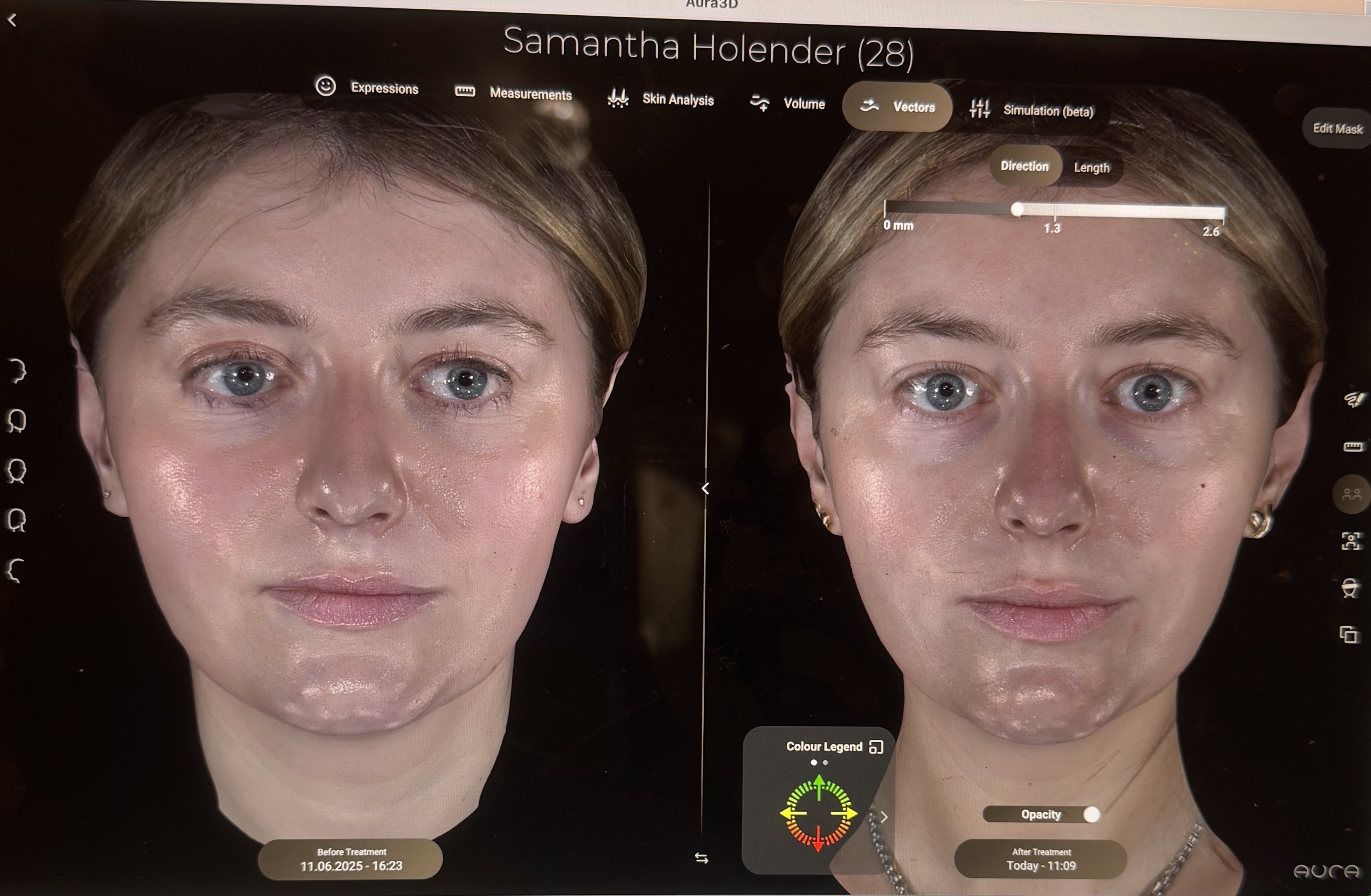
Samantha Holender before Sofwave (L) and four weeks after Sofwave (R).
But! Then other people started commenting. Saying that I looking different. Not good or bad per se, but pointing out that something had changed. I dyed my hair a little blonder at the time, so I thought it could potentially be that, but the second I saw the results from my second Aura Skin Analysis, I knew I A.) wasn’t delusional, and B.) my different appearance was fully due to the Sofwave.
I stared at my before-and afters for a good 30 minutes in utter disbelief, and proceeded to send them in our Beauty Team slack, my family group chat, and to every friend in my contact book. See it to believe it, right?
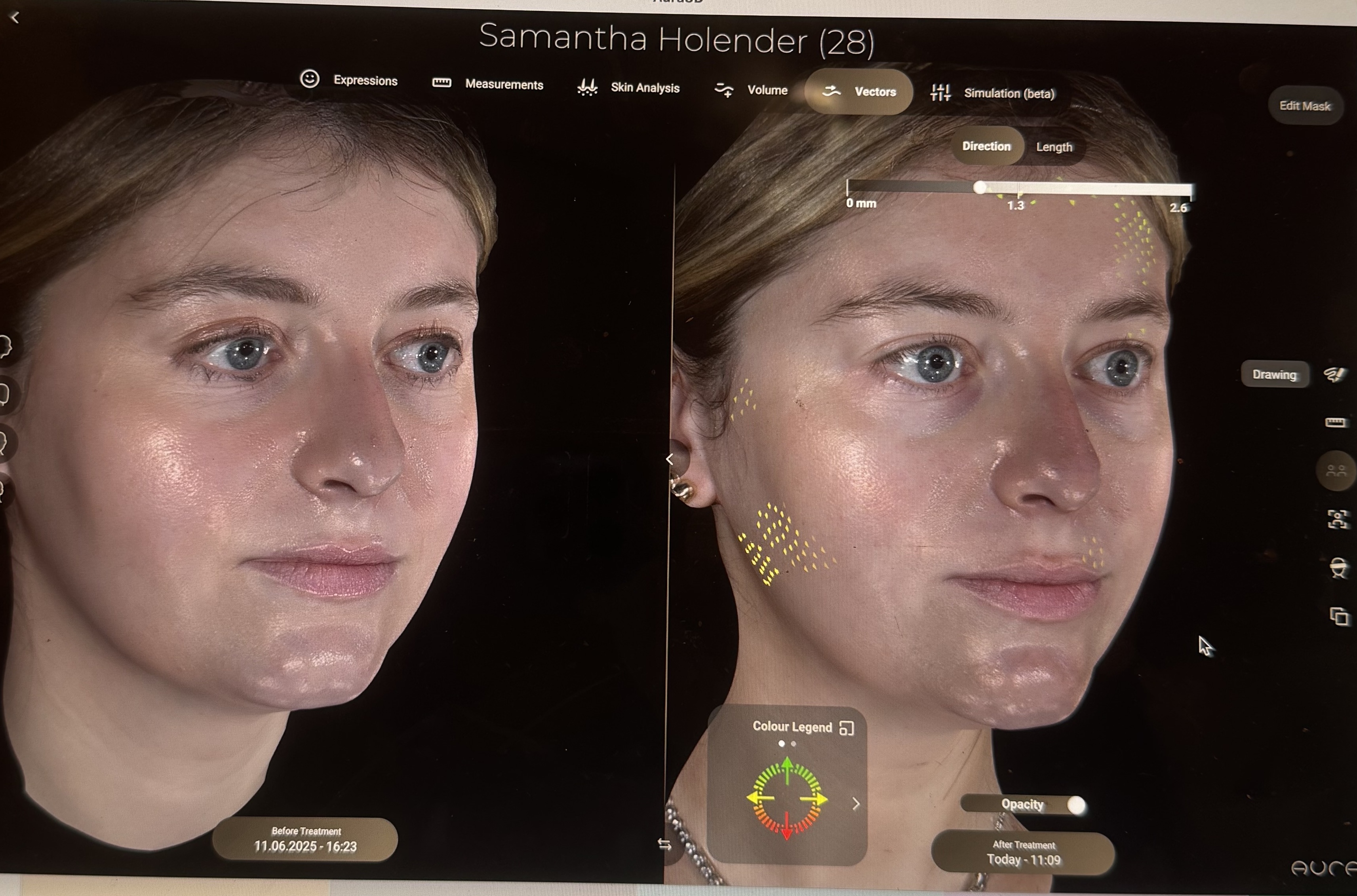
Samantha Holender before Sofwave (L) and four weeks after Sofwave (R).
Eight Weeks Post-Treatment
The wild results that I saw in just four weeks aren’t always going to be the case. Everyone reacts differently and in a varying timeline with factors like age, skin quality, and collagen playing a role. That being said, I wasn’t too shocked when my progression seemed to stall a little bit between four and eight weeks.
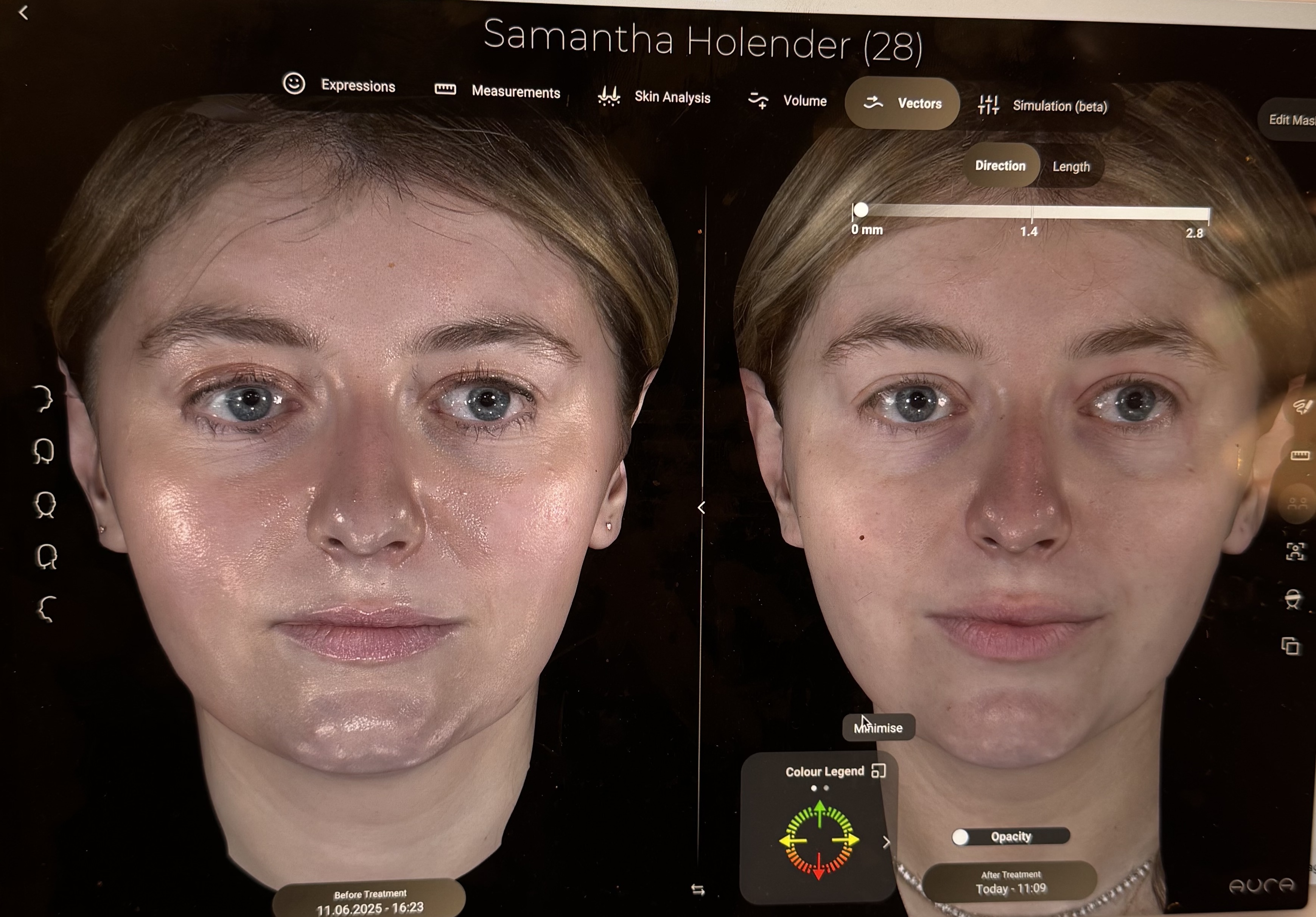
Samantha Holender before Sofwave (L) and eight weeks after Sofwave (R).
I still saw a little bit of improvement in terms of lifting, but it wasn’t nearly as dramatic as what I saw at the four week mark. But looking at the progression of where I started to my end result, had my jaw literally on the floor. The full results won’t be visible for another month or so, but I’m genuinely thrilled with my current before and after.
My Takeaway
Sofwave is easily my favorite aesthetic treatment I’ve ever tried. I still look at my before and after photos once a day just to remind myself how dramatic they are. It’s not a pain-free experience, but for me personally, it was so incredibly worth it.
I highly recommend getting before-and-after photos on a machine that has the ability to measure the slimming and lifting effect, too. I found it so nice to have tangible proof that what I saw in the mirror was reflected in measurements.
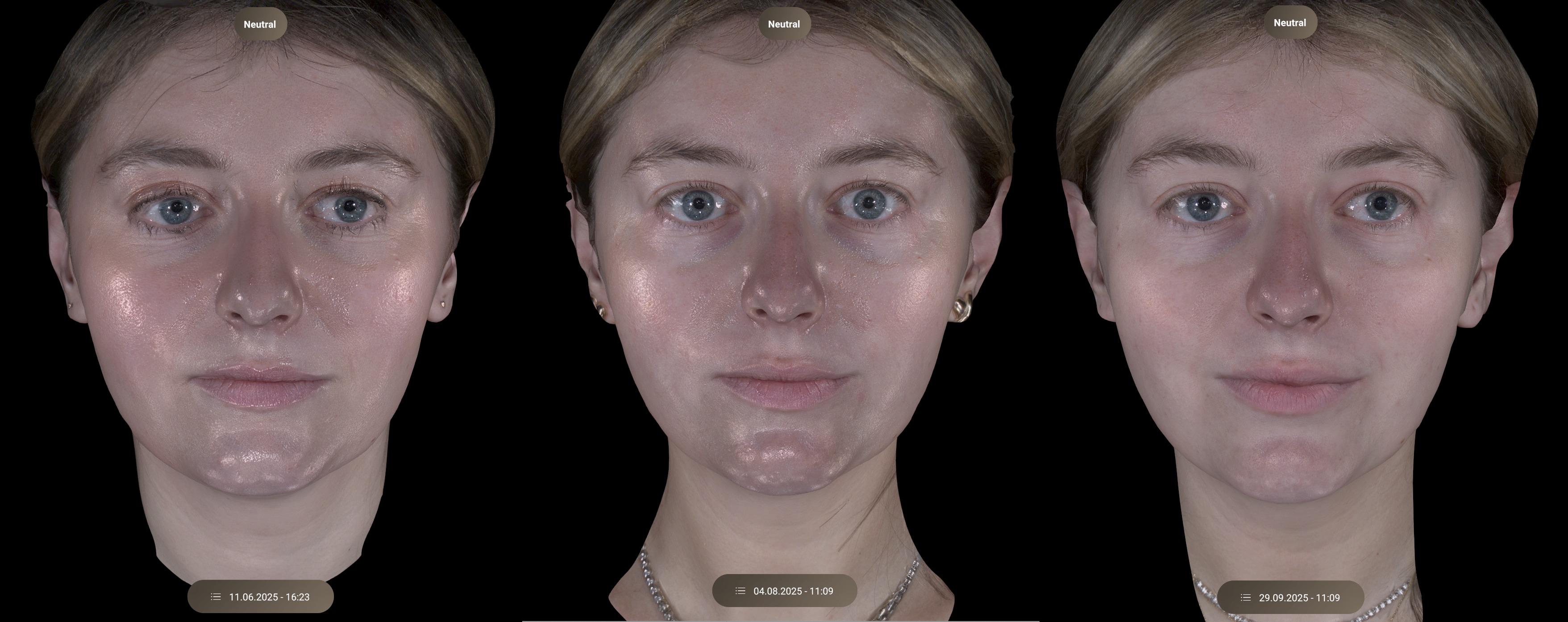
Samantha Holender before Sofwave (L), four weeks after Sofwave (M), and eight weeks after Sofwave (R).
As always, your provider is everything. Sofwave results are generally very consistent, but it’s still important to make sure you’re going to a licensed aesthetician, nurse practitioner, or physician. If you’re in the New York City area, I can’t recommend TREAT Medspa enough—the office was beautiful, the staff was friendly (and knowledgeable), and I felt like I was in the best hands from start to finish.
The only downside? The results are not permanent, so I’ll have to do Sofwave roughly every year and a half in order to maintain results. But I have a sneaky suspicion that my mom and grandmother will be coming with me next time. Who says jawlines have to be genetic?
Why Trust Marie Claire
For more than 30 years, Marie Claire has been an internationally recognized destination for news, fashion and beauty trends, investigative packages, and more. When it comes to the products Marie Claire recommends, we take your faith in us seriously. Every product that we feature comes personally recommended by a Marie Claire writer or editor, or by an expert we’ve spoken to firsthand.
Meet the Expert
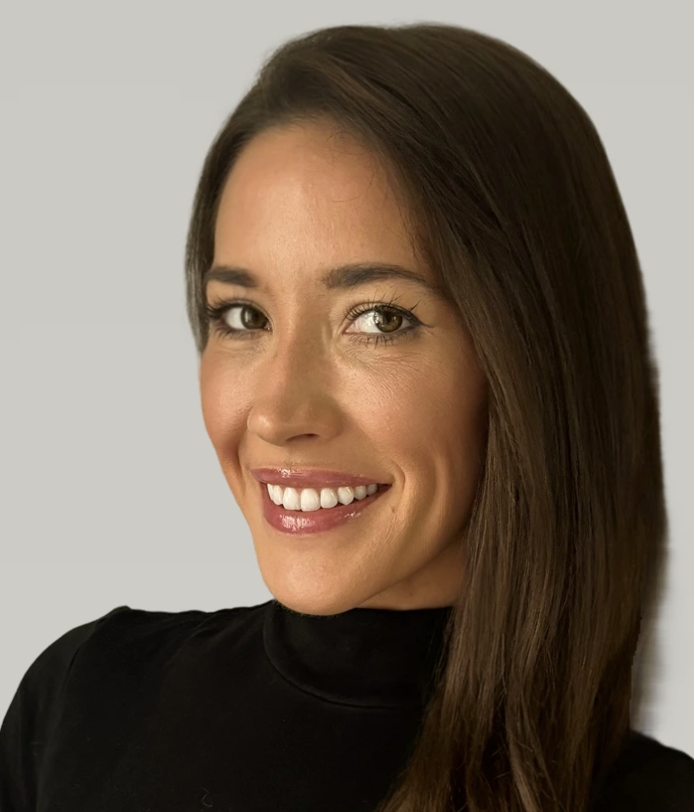
With over 18 years of experience in medical, health and aesthetic sales, Sarah specializes in growing best-in-class beauty and wellness brands. As Chief Growth Officer at TREAT, she oversees go-to-market strategy, partnership development, and client acquisition, bridging innovation with execution.
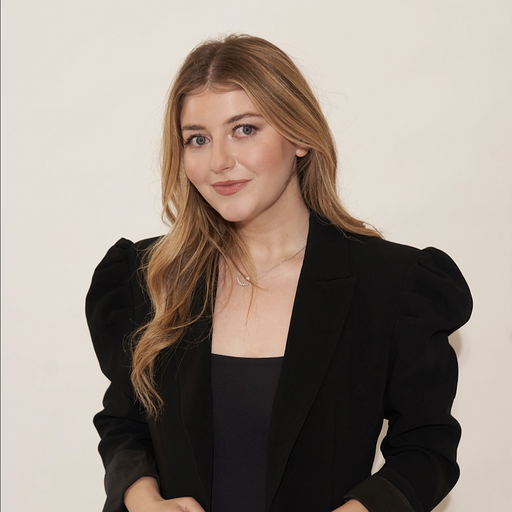
Samantha Holender is the Senior Beauty Editor at Marie Claire, where she reports on the best new launches, dives into the science behind skincare, and shares the breakdown on the latest and greatest trends in the beauty space. She's studied up on every ingredient you'll find on INCI list and is constantly in search of the world's glowiest makeup products. She's constantly tracking the biggest nail and hair trends to pop up in the beauty space, going backstage during fashion weeks, tracking celebrity looks, and constantly talking to celebrity hair stylists, nail artists, and makeup artists. Prior to joining the team, she worked as Us Weekly’s Beauty and Style Editor, where she stayed on the pulse of pop culture and broke down celebrity beauty routines, hair transformations, and red carpet looks. Her words have also appeared on Popsugar, Makeup.com, Skincare.com, Delish.com, and Philadelphia Wedding. Samantha also serves as a board member for the American Society of Magazine Editors (ASME). She first joined the organization in 2018, when she worked as an editorial intern at Food Network Magazine and Pioneer Woman Magazine. Samantha has a degree in Journalism and Mass Communications from The George Washington University’s School of Media and Public Affairs. While at GWU, she was a founding member of the school’s HerCampus chapter and served as its President for four years. When she’s not deep in the beauty closet or swatching eyeshadows, you can find her obsessing over Real Housewives and all things Bravo. Keep up with her on Instagram @samholender.